Top 5 tips for successful Mobile Application Testing

There are millions of mobile apps available in the market today. The statistics shows that since 2016, on an average around 6000 apps on Google play store and 1400 on the Apple store have been released every day. In order to be hassle free and to be on top of the competitors, an app needs to be stable and be properly tested.
Testing on mobile devices could be very challenging as it has to constantly be in touch with the new updates, new features and a myriad of DevOps tools that get introduced every time to ensure better performance and reliability of the mobile app.
Hence, there are many factors that have to be considered while framing the testing strategy in order to avoid all kinds of uncertainties in the app performance, just needs a right planning.
Below are five strategies every mobile testing team should keep in mind in order to reap the most benefits from their QA efforts.
1. Real Environment Testing is a must
2. Testing Automation
3. Functionality Testing
4. Performance and Load Testing
5. Choice of Mobile App Testing Tools
1. Real environment testing is a must
Emulators are the best option only at the early stage of testing, and they have a vital place in the overall QA process. But testing on emulators is not successful for all types of testing. All the tests should not run on emulators as those will not be reliable for an app to run immaculately in the real world scenario. Testing on the real devices is certainly more accurate as it can test many device functionalities like camera operations, battery life, GPS, Bluetooth, networks and more. Each device is designed differently and emulators do not solve issues specific to a particular type of device.
Procuring multiple devices and testing the app on each Operating System can be quite a daunting task and it may seem next to impossible to test the app on every OS combination. The best way would be to test apps on a cloud based platform with a hub of real devices. This way your testing results would be more precise and the procurement cost could be controlled. pCloudy has a wide variety of mobile devices available on cloud that can be considered as the preferred option.

2. Testing Automation
Automation testing is the key and the most vital when it comes to mobile apps. It can ease the execution of tests to run simultaneously across real devices which speeds up the entire testing process allowing the apps to float in the market quite earlier and faster. In the cases where the tests require a lot of set up and aren’t the routine tests, manual testing should be preferred over automation. Mobile Automation testing necessitates the use of right automation tools. The choicest one is Appium which is open source and supports both iOS and Android and also allows to write the tests that can run on both the platforms.
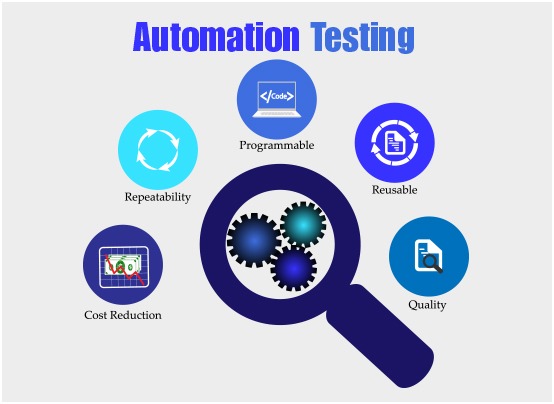
3. Functionality testing
The core functionality is the main draw for any app and it has to be rock solid. People seek out apps to perform specific functions. Incomplete or inadequate functionality will result in abandonment, so make sure that the main functions are fully implemented and tested before you move on. User experience really matters and is also a key factor in an app’s success. For example, if the elements of the app are placed incorrectly on the mobile screen, the user will not use the app and uninstall it straightaway. So, the mobile app needs to be tested on each functionality in order to give the best results.
4. Performance and Load Testing
Usual tests are performed at earlier stages to identify the bugs even before they are pushed for production but the performance and load tests are performed later in the SDLC process to assess the maximum operating capacity and behavior of a mobile app in real life load scenarios. Tools like JMeter and Android’s Monkey tool are often used for performance and load testing. Also, the app performance on real devices is done in order to check the issues like network interruptions, memory leaks. Whatever the choice of tool may be, the goal is to ensure the smooth functioning of the app before and after the final release.
The Internet speed can also have a major impact on the experience of using an app. A user connected to a slow cellular network might have a hard time with apps that have rich media content. Make sure your app testing includes slow connections — and fast ones — to make sure the experience is OK at any speed.
5. Choice of Mobile app testing tools
It is very important to choose the right tool for mobile app testing. There are many favored mobile app testing tools to do the right testing.
Out of the meagre tools available in the market, Appium tops the list of the most preferred open source mobile testing tool in the market. Other than this, the tools like Robotium and Espresso which are used widely to test the Android apps by empowering the testers to write UI tests for Android Apps, easily. Google’s EarlGrey performs the similar function as Robotium for iOS framework.
Conclusion
To conclude, we must acknowledge that the decisions related to successful mobile app testing is the key role of the testing team. Testing landscapes keep changing and the testing strategies have to be aligned with the vulnerabilities of the market. It can be deduced from the above discussion that both emulators and the real devices are needed as per the testing situation. Performance and load testing are the saviors and must be performed sincerely in the production to understand the reaction of the mobile apps at different load conditions. There should be a right combination of the testing tools as per the type of operating system where the app has to be installed. To make the Mobile app testing a success, the right decision-matrix regarding the above mentioned points would prove to be the strongest pillar of the QA team of an organization. To know more about the mobile app testing success, visit www.pcloudy.com .
Test your apps on real android and ios devices. Click Here.
Mobile Application Testing, Manual App Testing , Automation Testing , Mobile App Testing Tools , Mobile App Testing Platform , Mobile Responsive Test , Mobile Device Lab , Mobile Test Lab , Android App Testing , iOS App Testing , Mobile Testing , Mobile Device Testing , Mobile Test Automation
3 Reasons why test automation should be included at the API level

QA & testing become indomitable especially in the context of API testing. The development teams benefit from automated integration tests at API levels as it helps them in easy integration of apps and higher product adoption rate, ultimately helping the firm increase their profits. API layer is frequently ignored while developing and executing automated tests and mostly end to end user interface driven tests are executed to check if final application works perfectly after integration. API layer is not to be ignored and for a QA strategy to be successful, it should consider API testing as a fundamental part of the overall testing strategy.
Let us understand what API testing means:
Application Programming Interfaces (APIs) are a set of programs that allow two or more software to communicate with each other and be able to exchange data smoothly. In the testing world, testing APIs is different than other types of testing. UI and functional testing is often given importance while API testing is ignored. The foremost responsibility of a tester is to ensure that API testing is performed in order to attain seamless functioning, performance, and the reliability of different data-driven applications and systems by verifying exchanges and communications between applications, systems, databases, and networks.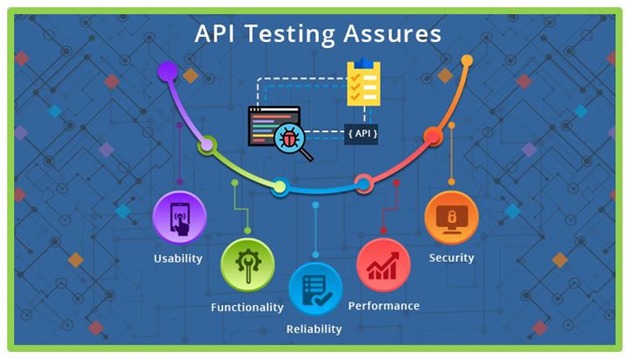
While integration testing has been a component of the test automation pyramid since its inception, it’s also been the most undermined layer in functional test automation. All tests that supercede the scope of an individual unit, and can’t be covered by unit testing are often executed through user interface-driven, end-to-end test scenarios. But while end-to-end tests can be seen as the ultimate integration test, where all components come together, having too many of them leads to test suites that take unnecessarily long to execute, and that are hard to maintain and keep stable. It’s often possible to test important parts of an application’s technical and business logic through an API. To understand the importance of API Testing more in depth, let’s understand the undermentioned benefits of Automated API testing:
1. Wider Scope than Unit testing
2. More Stability and Speed as compared to end-to-end tests
3. Introducing API Level Testing more seriously- A significant decision in Automation Testing
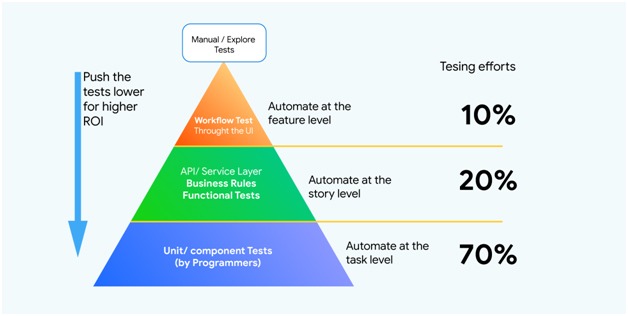
Wider Scope than Unit testing:
Unit tests are often run on small group of components within a single application layer. Issues are often not detected in distributed apps where one application layer ends and the next one begins. In order validate if the components are communicating as desired, API level tests are designed. So, the need of a strong API testing Strategy is of dire importance at the integration level especially when it comes to integrating with external components. Managing the testing environment is a critical task to perform especially when the components are with different teams.
More Stability and Speed as compared to end-to-end tests:
It is true that end-to-end tests are vaster in scope than API testing. They cover all the layers and components of the application but API tests cope up with its loss with its stability and speed. API tests are certainly faster than the former. End-to-end tests take longer time to load browsers and screens whereas API tests are based on individual request-response interactions (for example in JSON or XML format)which makes the execution faster with shorter feedback cycles. Moreover, user interfaces tend to change frequently due to various user change requests and adherence to advanced front end frameworks API tends to be more stable in terms of Interfaces that yields fewer faults and requires less maintenance.
Introducing API Level Testing more seriously- A significant decision in Automation Testing
API level integration testing should be a mandatory aspect of any automated testing agenda. It could be an unnerving move for those with no prior expertise in this area. It is mostly the tester’s cup of tea more than the developer’s as it can go beyond the component or application. The absence of user interface can be a blocker in accessing and testing the API. But you can opt from various automated API testing tools available in the market. Tools like RestAssured, SoapUI, and Postman are preferred among the most.
Conclusion
In the era of Artificial intelligence and IoT, the need for API tests is becoming intense. Automated API Testing strategy is the most effective strategy for faster delivery and reduced human inaccuracies. With the help of the tools, more API test requirements could be covered and API testing could be made more advantageous for secured and quality deployment of mobile applications in shorter time. Why don’t you integrate your automation framework using pCloudy’s API and make your app release faster?
Test your apps on real android and ios devices. Click Here.
Mobile App Testing , Mobile Application Testing , Android App Testing , iOS App Testing , APK Testing , Mobile Responsive Test , Mobile Device Lab , Mobile Test Lab , Mobile App Testing Tools , Mobile App Testing Platform , Automation Testing , Mobile Device Testing , Mobile Test Automation
8 common Appium Mobile test automation mistakes and how to avoid them
As we all know that Appium is the most preferred test automation tool for mobile applications. It is the first choice of the testers because of its flexibility i.e. it is open source, it has the best supported and highly active community of experts, Appium works across different platforms and works well with different scripting languages. Even after gaining such a popularity and having a strong community base, surprisingly,the users still make mistakes while running the mobile test automation with Appium.
Here are a few common mistakes that Appium users encounter while using Appium Mobile Test Automation Tool:
1. Unrestricted X Path Usage:
Over usage of X Path could be found in case of Selenium as well but when it comes to Appium world, it has more outrageous effects because X Path is a more dynamic way to unearth the elements. But the biggest stumbling block in this scenario is its huge performance cost due to which it becomes elusive an area. This is because Google and Apple do not provide XML or XPath related queries in a way we would need them to be. All of this hospitalizes an unmanageable cost finding elements using X Path. Undoubtedly, X Path is the most trusted method but there are several other better locator methods like ‘Accessibility IDs’ that can be used in this sitch.
2. Neglected usage of Accessibility IDs:
The accessibility ID locator strategy is formulated to read a unique identifier for a UI element. For both iOS and Android, getting an element by their accessibility ID is the best method. Most importantly, it is preferable because it is quicker. It should be noted that semantically accessible IDs are different than the Web IDs. However, the two shouldn’t be combined. In many cases, the accessibility IDs are used only for the purpose of testing even though they have a larger purpose. So, in order not to spoil the accessibility of the applications just for the sake of testing, the bigger purpose of the accessibility IDs should be known. If the accessible IDs are set up on the elements to make the apps testable, the app accessibility also increases, provided that the accessibility labels are sensible to the users using them. But the foremost criteria not to make automation efforts a failure is to make the application testable in the first place.
3. Not making a testable App:
Developing an app should be a forecasted move where in the developers, even before writing the first line of code, plan to develop an app keeping the automation in mind. This they can achieve by keeping in mind the hooks and the unique IDs for the elements in order to make the app more testable. This strategic approach would be a reason for a successful mobile app testautomation. Apart from this, there should also be a concentration on the different testing scenarios in order to elude the chances of overlapping before even getting into Appium coding. An open discussion forum with the development teams to discuss the plotting of right accessibility IDs, labels or Unique IDs for the application’s elements would reduce many test automation reliability concerns.
4. Disregarding Application View States:
One of the challenge faced in Mobile Test Automation is not setting up the application. Most of the developers do not set up the application in order to access specific views and user states rapidly. To quote an example given by Jonathan Lipps,one of the key contributors to the Appium project.
A shopping cart functionality of the app might have ten different tests, and ninety percent of the tests might go through the same steps of logging in and searching items to be put in the cart which is a huge waste of time.
So, your team should be able to set up an app’s state and start the test in that apposite state, straightaway. This is highlighted in Appium scenario due to the fact that the mobile simulators and emulators are slow and take longer than usual to reach to the right position on the test.
5. Query for every element visibility:
Not querying for the visibility of every element is another way to speed up the run-time of the Appium test scripts. This leads to an additional load of calls and waiting time for Appium while in the every activity of retrieving an element. The lag can be reduced by only requesting the element attributes which are important in perspective of the test code.
6. Native Testing tools — Always better?
According to some developers, usage of the native testing tools is the best way to get unfailing mobile tests. For example- Espresso in case of Android and XCUITest in case of iOS. This is not a good advice as neither of Google or Apple are going to release and new automation technology. When the question is of stability, the stability of code should be chosen rather than technology and in this scenario, Appium is the best choice!
As an exception, if the development team writes the tests and it’s most comfortable in mobile SDK language, using Google and Apple providers to build development environments. Also, when the constricted test-app or test code-app code integration is needed, then Appium might not be of much help. The utmost value is that Appium provides the WebDriver layer on top of the technology, which means the code can be written in any language and acts as a stable interface to that specific automation technology. Also, being a cross-platform tool, Appium allows to saves a lot of code and architecture in case of testing both iOS and Android devices.
7. Appium is slow:
Appium might be slower in some circumstances and also there are points in Appium codes where it does not seem efficient. Appium backs upon technologies that are slower than Appium and the curators of Appium have strategically chosen to utilize slower strategies for specific instances. For eg: Appium will certainly be slower if you are relying on XPath. The efficiency of the tool depends on how it is being used. Mostly, Appium is favored because of stability than the speed.
8. Not Using Appium Documentation:
The earlier Appium docs were not very user friendly. As a result, they weren’t used as much as they needed to be but the new Appium documents have been completely redesigned and reorganized. Information about the API reference to Appium, client libraries, supported drivers and Appium commands, code examples which was not provided before is all documented in the updated version. It deserves a revisit due to its newness and can be accessed at Appium.io.
Mobile Testing , Mobile Responsive Test , Mobile Device Lab , Mobile Test Lab , Automation Testing , Mobile App Testing , Mobile Application Testing , Android App Testing , iOS App Testing , Manual App Testing
Mobile Devops+Agile – Challenges and Keys to success
Delivering a high qualified software is not a Unique Selling Point anymore but a perquisite for better customer experience. In the present era, the customer is very educated about the choice and comparison between the best services or products. Along with quality goes the promptness in service delivery. In terms of Quality Assurance, both can be achieved by implementing Agile and Devops best practices. The developers have achieved a lot in terms of solving quality issues and delivery with the help of automation. To ensure the constant success in this maneuvre, the firm has to ensure that the metrics to be tracked are chosen rightly in order to maintain the quality throughout the development process.
The delivery of mobile apps is done differently than other ordinary apps. Although the elements of Devops – agility, Continuous integration and continuous enhancement are followed in both the cases but specifically in case of mobile apps, there has to be a unique strategy and tools.
What are the mobile application delivery challenges?
Mobile apps are built for smaller screens, need of touch output are completely different than that of web apps which need mouse or keyboard. Apart from these, it faces other challenges like:
Fast Delivery
Mobile app users are used to fast service of apps, automated updates and quick response time. So to maintain the competitiveness, the mobile app industry has to focus on methods and tools that leverage quickness and quality of the output delivered. The faster the performance of the apps and updates, higher will be its chances to overpass the competitors.
Design and build of Mobile Apps
Mobile apps are built on a different understructure. The entire build and design exercises have to be executed and tweaked according to the screen size and device architecture. Also, based on the advantages of mobile device, the apps should utilize the features like camera, GPS, Bluetooth, voice/video calling to give an edge to the app’s friendliness and captivating ability. If the mobile app is poorly fabricated, it will quickly drive away the users.
Competition in the market
As per the latest statistics, there are about 2.8 million Android apps and 2.2 million apps available on Apple store and thousands more are released each month. The app with the unique features will only be chosen and the competition increases as the mobile device market advances.
App Store dependability
Who knew that app store would be a challenge? Yes, most of the times the apps cannot be deployed directly to the device, it has to go through the app store. This acts as an additional step in the process which delays the app deployment on the user’s device. It also restricts the developers to push direct updates or critical bug fixes in the app. So instead of being a ‘continuous delivery’, it becomes ‘awaited delivery’.
Above are some of the most common challenges that are faced in mobile software delivery but how to meet these challenges?
The Devops team can follow a more analytical approach to the software delivery with a concrete set of Devops principles.
1. Early monitoring:
Most of the organisations tend to monitor their built apps only in the production stage after releasing it to the end users. This is the biggest mistake they can do. The DevOps team will have to reconsider this practice and work on a different approach by monitoring the critical measures at pre-production stage. Continuous monitoring and making early stage improvements would really matter in the overall app success.
2. Achieve quality at good Speed:
To achieve the ultimate success, the DevOps team has to focus on quality with speed and also consider the cost it would incur. To accomplish this powerful goal, the team has to adopt DevOps and agile practices alongside. According to forrester analytics reports, the firms who have adopted this approach has seen a rise in the benefits like technical and functional quality, and high delivery frequency. By emphasizing on building the expertise of the resources, implementing continuous testing, involving testers as a part of integrated testing phase, automating end to end functional testing and by implementing shift-left testing at all levels of development cycle, the firms give the software testing a new face leading to business transformation.
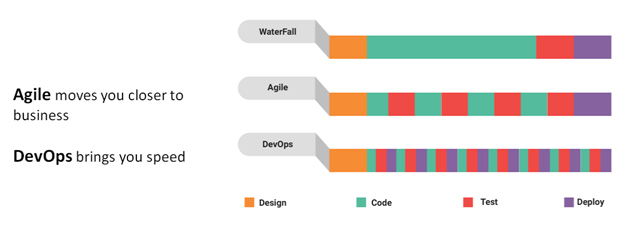
3.Multiple Channel Visibility:
Mobile apps have to be built for serving different platforms. Along with the web version of the app, the Devops team has to deliver a mobile version in most scenarios. In order to attain this understanding, developers need to analyze what is the journey of the users when they decide to switch from web to mobile apps and one device to another. This is a critical data that would be the deciding factor in developing the app for different channels.
4. Automating to the maximum:
As per the Forrester study conducted on the success of advanced Devops+Agile firms, the firms have automated most of the testing processes by 50 percent in order to reap the benefits of successful Mobile Devops. The result is faster and quality software delivery by continuous testing implementation.
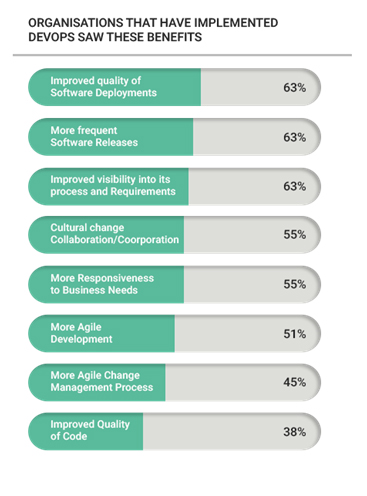
5. Constant feedback:
This is the most discussed and the most important point. The developers must identify the issues the application is facing in all the stages of delivery in order to take corrective actions on time. DevOps team has to be vigilant and responsive to all the issues that arise at every step. In this fast-paced Mobile app development market, this is a must have key point.
Conclusion:
Mobile DevOps is a distinct software practice which is built on top of the traditional DevOps mechanism. It demands an extra attention to all the processes in order to produce a fast and quality software delivery, extraordinary application design and commendable user experience to facilitate success in the mobile application market. It carries a bigger picture by focusing more on the ‘business DevOps’ rather than just ‘DevOps’. To attain maximum DevOps Feat, the DevOps team has to be a step ahead in adopting new analytical approaches at every step of development and delivery. It has to be instinctive and provide continuous visibility to the delivery pipeline to gauge the ultimate app performance in the User market.
Sign up for FREE TRIAL to test your apps on Real Android and iOS Devices. Click Here.
Mobile Device Lab , Mobile Testing Lab , Mobile Test Lab , Mobile Testing , Mobile App Testing , Android App Testing , iOS App Testing , Automation Testing , Mobile App Testing Tools , Mobile Application Testing , Test an app , Mobile Resposive Test
Managing QA Dilemmas with Appium Mobile test Automation
With the rise of myriad of mobile applications, operating systems, device platforms, networks, the need of quality testing becomes most critical. Automated mobile testing is still an ingenuous concept in the Quality assurance industry. Mobile app testers were facing serious challenges until the emergence of Appium as the most reliable open source mobile test automation tool for testing Android and iOS apps. It reduced quite a number of challenges faced by testers and became a tester-friendly tool for automated mobile app testing. According to the world quality report 2017-18, the most common challenges that the QA team faces are lack of time in-house test environments, testing expertise and the lack of right tools and approaches to test the mobile apps, , difficulty in integrating test automation into a devops process, etc.In order to overcome these problems, there has to be a shift in the strategies and methodologies at a much deeper level for an improved customer experience.
Below are some of the challenges pointed out based on the experiences mobile app testers faced in Automated Mobile app testing:
Test Execution on multiple devices: It is difficult to deploy and run tests on different device environments. It is easy to buy and run tests on lesser number of devices but when the number is more, running automated testing on all devices becomes a bit tougher and time consuming. It is always a good idea to consider cloud services like pCloudy when testing large number of devices. pCloudy Appium integration architecture make developers' life simpler with lesser changes in the code. You just need to mention some desired capabilities instead of calling APIs or doing changes in the code to run the Appium scripts. You can run tests in parallel on more than 500 devices. And wonder what! it makes you save 50% of your app testing time.
1. Device Connectivity: Devices come with different features. Some devices have certain limitations in terms of security, accessibility and drivers. Some features of the app that run on one device might not run on the other. So, the devices that would be used for testing would differ a lot in features hence the problem may arise at this level.
2. Test Performance: Testing on the Real devices is most effective as everything is validated on the real situations, especially in the case of testing performance and testing applications under different network conditions. Many of the gestures like GPS, proximity sensors, life sensors, etc cannot be tested on simulators. An application tested on emulator might not always work same on the real devices. There might be an incongruity in the same OS across different devices, let alone different OS. A device cloud testing can also be considered in the scenarios where there is a need of large scale device testing.
3. ACcess to networks: In order to have a smoother functioning, it is mandatory to have an easy access to the networks, databases and web services. In case of working with remote services, configuration of device tunnels and VPN connection would be required to have an easy access of resources. pcloudy'sDevice tunnel provides the developer a full control over the device on cloud. Through this, the cloud devices can be accessed via Android Studio or Eclipse IDE installed in the computer. This has helped the developers and testers to enter any kind of device hosted on cloud for running quick evaluation and app debugging sessions.
The above were some of the challenges of the Mobile app testing Automation but how does Appium solve these issues?
- Appium supports Selenium Webdriver API which most of the testers are familiar with
- No need to modify code of the application that is being tested.
- Appium supports chief programming languages like JAVA, RUBY, PYTHON, C# etc.
- Appium supports both IOS and Android mobile platforms
- Appium has a huge community of users and is an open source tool.
However, it does have its own challenges on some of its versions. Challenges like it doesn’t support image recognition, not all features are available on both Android and IOS simultaneously, some APIs are not implemented, etc. Despite of these drawbacks, Appium remains the best choice of the testers.
PERFORMANCE OF APPIUM ON REAL DEVICES AND CLOUD
Which environment is the most favorable one for the Appium performance? Is it on real devices or on the cloud?
- On Real Devices- real device environment is the best to perform regression testing when it comes to providing real time user experience. But real devices always carry a baggage of being unscalability when it comes to handling large number of platforms. Its performance and test usage is high on real devices, parallel testing could be executed. It is best recommended when the device coverage is lower and handling the cost of multiple devices is not an issue which is a rare case.
- On Cloud – Could is the best, affordable and scalable choice even in the case of large number of platforms. It can provide access to many devices to run tests at the same time. Cloud has other benefits like it can capture reports with screenshots and videos, support from the Appium cloud community,etc. It has an average performance on cloud services, parallel execution is possible even in this case. This is a highly matched scenario in the case of compatibility testing, regression testing and where the device coverage is high
Below table showcases the comparison of best test environment for optimal automation testing:
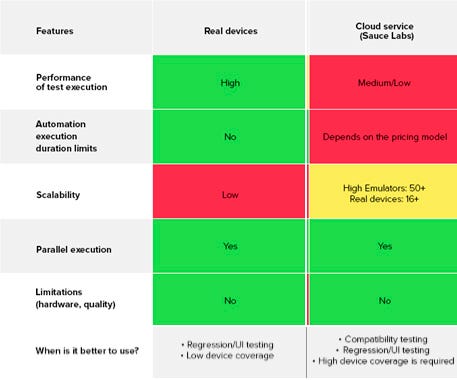
Conclusion:
With the advancement in technology comes both opportunities and challenges. As the customer becomes technology friendly and aware, the pressure to provide the best would prevail and the QA community has to be a step ahead to deliver the best customer experience. They would need to tweak the methodologies, approaches and use the tools adept in handling technology advancements. Use Appium as a preferred mobile test automation tool is highly recommended. It supports Android and iOS and also the same code can be applied to both the platforms, it minimizes efforts, costs and saves time. It is open-source, free and has API based on Selenium which is practices by most of the testers. As of today, Appium serves the purpose even when aligned with pcloudy’s testing environment.
Mobile App Testing , Mobile Device Lab , Mobile Responsive Test , Automation Testing , Android App Testing , iOS App Testing , Mobile Testing Tools , Mobile App Testing Tools , Apk Testing , Mobile Application Testing , App Testing , Mobile Test Lab , Mobile Testing Lab
Moving Beyond Traditional App Testing with AI and DevOps
Are we not living in an amazing time? Technologically advanced, digitally sound!
We thrive on all things digital. The world around us is becoming all digital with limitless possibilities. Today as a consumer, you can preorder your coffee, interact with augmented reality in the store, and skip the lines at store with alternative payment methods.
To cut the story short, as a consumer, we have access to unlimited goods and services and connected around us. And mobile is at the center of all this change. It's the tool that is bridging the gap between the digital and physical.
And the availability of 5 million apps come as a proof of this explosion. In the first quarter of 2018, Apple had 2 million apps on App store. As of the same quarter, Android users were able to choose between 3.8 million apps. More and more businesses are adopting Mobile Apps as their primary channel for business growth. This explosion proves that mobile is at the core of customer experience.
Before moving further into the topic, you can watch the entire webinar here or else you can skip the video and continue reading to get the gist of the webinar.
As a business mobile Apps are not just another channel. More and more organization are realizing that it can be a means to create awesome customer experiences. There are numerous examples to illustrate.
One such example is Starbucks.
The secret to Starbucks’ app’s success is that it gives users an intuitive experience, making it as easy to find a store, order your coffee and make a payment through their wallet. Recently, Starbucks has also taken the mobile app experience one step further with an innovative conversational ordering system powered by Artificial Intelligence (AI). The explosion in mobile apps imply to speed. How quickly you can make a change and let the customer experience it? The mathematics of velocity matter here. Market speed has left companies with a simple problem: How do we go faster than we ever have before, without losing an eye on quality?
The success stories like Facebook and Netflix tell us that we can It is an amazing fact that Facebook mobile app is updated and refreshed every two weeks like clockwork. That’s the new normal. We will talk about this example in detail a little later in the webinar.
So in order to gain Quality@Speed, we reach to a point where experience and quality intersect and we name this convergence Quality@Speed. It’s a no brainer to say that Quality @ speed can be achieved with two fundamental principles.
Agile: Agility allows teams to work closely with business and it Pulls quality forward. It’s also called Shift Left of Quality. You are delivering small chunks to end consumers on weekly or monthly basis. This allows teams to get feedback early on.
DevOps: DevOps brings you speed. It’s a Shift left of operations.

DevOps practices allow you to create “ready to deploy code” on demand. In other words, it means deploying software and the environment on which it runs, automatically and on demand, at any stage of the software delivery lifecycle. You can truly have multiple deployment in a day.
If we dig deeper, DevOps is enabled by two practices Continuous Integration and Continuous Delivery. These two will not work in sync until you have continuous testing in place. It’s also proven by many independent studies.
Here, we have a look at the data extracted from World Quality report, 2017-18 showcasing the popular and the best practices followed in DevOps.

If we have a closer look at the data, we will find that 87% of CIOs and senior tech professionals use or are planning to use cloud based test environment. Depending on choice of organization, it could a Private or public cloud but it’s a must to achieve speed.
Second data point is about Continuous Testing, here as well more than 80% of respondents chose this as a preferred DevOps practice.
Let’s look at what some of the success stories say
Facebook follows Ship early and Ship often approach. They update their web app multiple times a day while their Mobile Apps with frequency of almost 2 weeks. This is possible with DevOps best practices they have been following from past few years.

If we analyze their DevOps story in short, we find that one of the biggest takeaway for Mobile Teams is their massive investment in device infrastructure. Every time they make a change to app, it gets tested on 2000 real devices. Imagine 2000 real devices! They have bypassed use of simulators/emulators.
Mobile DevOps Challenges
Now let us move on to have a look at some of the Mobile DevOps challenges that comes as an obstacle on the way of mobility teams.
Multi-platform Support
Mobile apps have multi environmental target. Mobile apps have to deal with device fragmentation as they need to be workable on multiple devices. This poses a test for Ops team to build an optimal device infrastructure. Moreover, it is difficult to keep pace with the ever changing device requirements.
Mobile apps as an enterprise front end
Mobile apps, that too, mostly the enterprise mobile apps catering to business-to-consumer (B2C) or business-to-employee (B2E) segment of apps, characteristically have very less trade logic on the mobile device itself. On the other hand, a B2C or a B2E mobile app serves as a front end to enterprise mobility already in use by the firm, such as transaction processing systems, employee HR systems, or customer acquisition systems.
This implies that the mobile app, available on multiple platforms as a native or Mobile Web app, needs to be built and delivered aligned with the backend services. The biggest challenge for DevOps is to think about enterprise mobility holistically and manage their build and release processes and cycles.
The App store
The app store includes an extra asynchronous step to the deployment procedure since developers are not able to update apps on demand. Even for grave bug fixes, new app versions need to pass through an app store submission and review process. Continuous delivery here gets a roadblock and the instant delivery becomes “submit and wait.”
Build Challenges
Since apps today are supported on multiple platforms, numerous different builds of the app has to be triggered each time when a change is being deployed by a developer.
The build system and configuration for each supported mobile environment is dissimilar from the others. You will probably require a small farm of build servers to be provisioned and available to manage these multiple operating system builds.
A typical Mobile DevOps Architecture
Let’s try to depict the Mobile DevOps cycle. Some of the tools mentioned here are a representative set of tools in the respective category.

It starts with a Dev checking in a code to Git/Versioning system. That triggers the CI server to build the App which could be Internal build server or a cloud system like Circle CI. Once the build is successful, Unit tests are runs on Real devices. If the Tests are pass, build is pushed to QA Env. Where Automated regression tests are triggered on real devices. If that’s a pass App compatibility tests for new features are done.
The Evolution
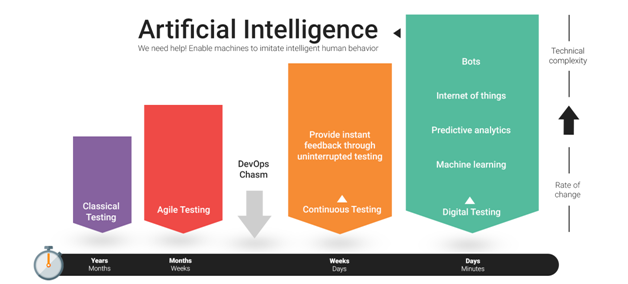
We’ve by now witnessed quite a journey to reach Continuous Testing. “Classical” testing was intended for software delivery cycles spanning months or year. Agile has changed this norm to a 2-week development iterations—but now something extra is required to meet today’s insatiable demand for software. Attempts to fasten the process further, created a chasm between Development, Test, and Operations. That gap has been bridged with DevOps and Continuous Testing in order to move beyond that speeding up plateau. However, when we look into the future, it’s clear that even Continuous Testing will not be enough. We need “Digital Testing” to achieve extra acceleration and meet the quality needs of future. AI can help us get there.
Mobile Testing and AI
If you keep pace with the market buzz you will find there is an ongoing debate about what AI can do? When it comes to testing, lot of theories have started predicting that AI has the ability to replace testing. Well personally I don’t see this happening in near future. But we certainly are very excited about capabilities AI present in from of us.
When we an organization think of using AI to sole testing problems we think on three lines
a) Can it improve speed of current testing process?
b) Can it help generate meaning full data for me to make intelligent decisions?
c) Can it improve the test coverage and reduce cost?
So, are you ready to adapt a personal assistant for testing. So are you ready to say? Certifaya, Can you run an App Test for me? pCloudy’s AI powered bot, can automatically test the mobile applications over hundreds of real mobile devices and gives its users real time insights into the app’s behaviour and performance. Do you want to explore more? Try Certifaya for free now and testify it yourself. You can also go through our webinar on the same topic to understand it in detail.
Sign up for FREE TRIAL to test your apps on Real Android and iOS Devices. Click Here
Mobile Responsive Test , Mobile Device Lab , Mobile Test Lab , Mobile Testing Lab , Automation Testing , Mobile Testing , Android App Testing , iOS App Testing , Test an App, App Test , Mobile App Testing , Mobile Application Testing , Mobile App Testing Tools , App Testing
5 Reasons why Appium is the best tool for Mobile Automation on device cloud
With Appium creating a buzz in enterprise mobility, mobility teams are still finding ways to successfully automate tests leveraging Appium. Appium being an open source tool is the perfect choice for automating native, mobile web and hybrid applications on their respective platforms.
Let us now see the major factors behind Appium being the best choice for mobile automation tool:
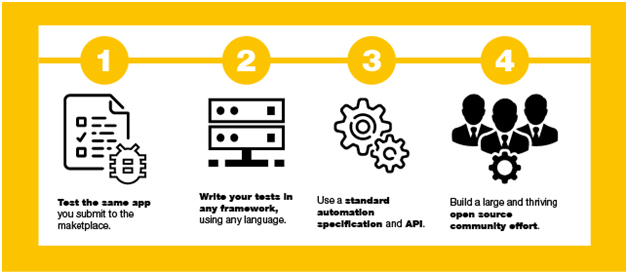
1. Use of standard API: Appium is widely popular because modification of codes or a recompilation of your app is not required as it uses the standard API in all the platforms. Appium makes it effortless to create your tests against iOS and Android platforms with same API. But, separate iOS and Android scripts are still needed as the UI elements vary on both the platforms.
2. Use any WebDriver compatible language: Appium gives the freedom from getting locked into a particular language or framework to write and run the tests. Any WebDriver compatible language like Perl with Selenium WebDriver API, Java, PHP, C#, Python, Ruby, Javascript with Node.js can be used for writing the tests.
3. Testing Framework of Choice: Appium gives flexibility to mobility teams to use testing framework of their choice. Earlier, tests could only be written through Javascript using the UI Automation of library for Apple or Java based tests could only be written through UI Automator of Google. Appium completely changed this scenario.
4. Cross-platform test automation: Having the capabilities to test on both Android and iOS devices makes it the best cross-platform mobile app test automation tool. In order to interact with Android and iOS with Selenium WebDriver, Appium uses the JSON wire protocol. Appium makes use of the libraries provided by Apple with the help of an application called Instruments to automate iOS apps. In newer versions of iOS after v9.3, the Instruments api has been deprecated and now use XCUITest framework.
The method is similar in Android also where Appium proxies the automation command to the UIAutomator test case running on the device. Android has a native UI automation framework called UIAutomator which supports running JUnit test cases from the command line directly into the device.
5. Open Source: Being an open source testing framework is one of the biggest advantages of Appium as it supports Simulators, Emulators, real devices, and of course, native, hybrid and web application testing of iOS and Android. Appium having a large and thriving open community makes it easier for new automation engineers to clarify their doubts.
Here is tabular representation for you to understand Appium’s compatibility with different features and tools.
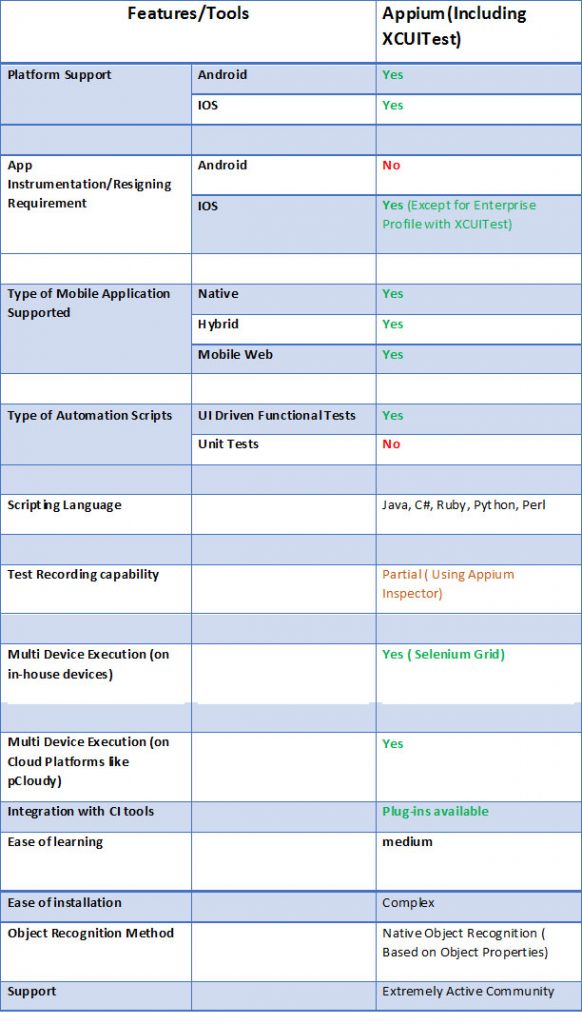
Why mobile device cloud with built-in Appium support?
Teams who are getting started with Automation or are considering Appium as an option, must explore an alternative to go for a mobile device cloud with built-in Appium.
A mobile device cloud not only assists in managing and sharing devices, but also helps in streamlining automated testing and continuous delivery processes. A mobile device cloud with built-in Appium makes it easy for teams to get started with automation and scale up later. Furthermore, it will give additional cushion against any sort of roadblock that might occur while using an open-source platform for tests. Let’s have a look at some of the benefits of having a built-in Appium support on a mobile device cloud:
- Supports parallel testing on multiple devices
- Reduces the complexity of test frameworks
- Creation of appium scripts become easy
- Streamlines the CI/CD process
At pCloudy, we are dedicated towards helping enterprise mobility teams make the process of mobile development, testing and device sharing seamless and faster by integrating it with cutting edge tools like Appium. Read this blog to get a comprehensive analysis sheet to quickly choose which open-source test automation tool will be right for your automation testing.
Sign up on pCloudy and automate your tests using best open source automation tool for faster and better delivery of apps.
Mobile App Testing , Mobile Application Testing , Mobile Testing , Test an App , Mobile App Testing Tools , App Testing